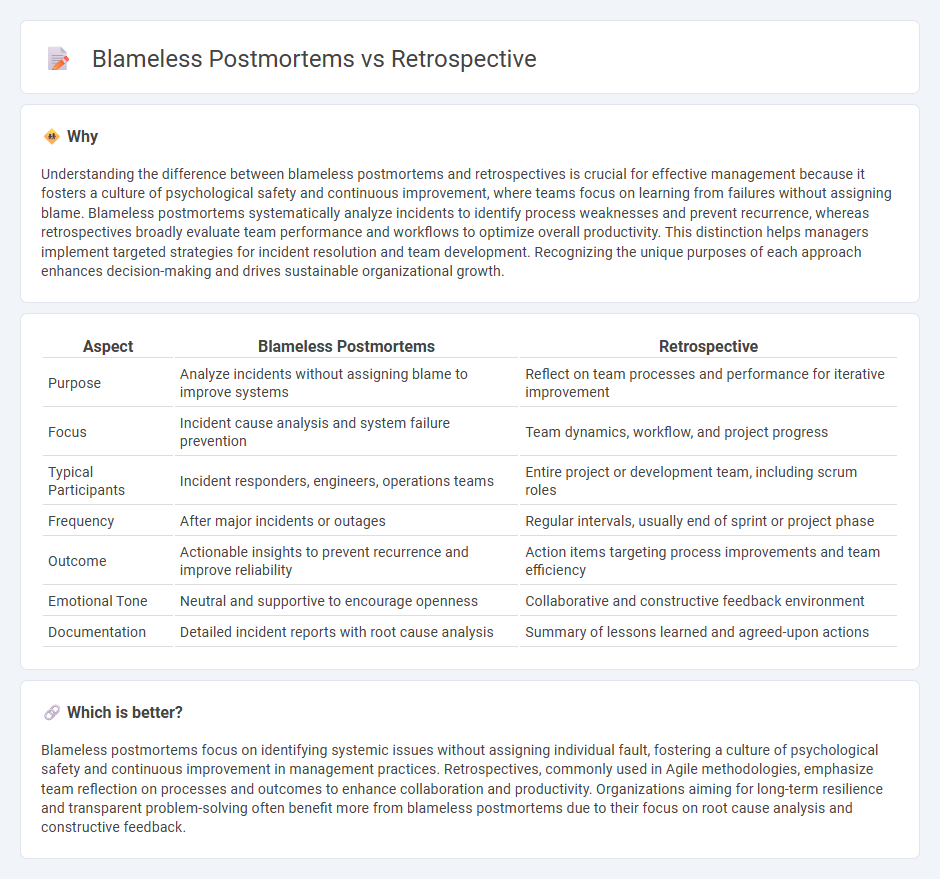
Blameless postmortems focus on identifying systemic issues and fostering a culture of continuous learning without assigning personal blame, enhancing team trust and transparency. Retrospectives, commonly used in Agile management, emphasize reflection on recent processes and team dynamics to improve future performance. Explore how blending these approaches can optimize your management strategy.
Why it is important
Understanding the difference between blameless postmortems and retrospectives is crucial for effective management because it fosters a culture of psychological safety and continuous improvement, where teams focus on learning from failures without assigning blame. Blameless postmortems systematically analyze incidents to identify process weaknesses and prevent recurrence, whereas retrospectives broadly evaluate team performance and workflows to optimize overall productivity. This distinction helps managers implement targeted strategies for incident resolution and team development. Recognizing the unique purposes of each approach enhances decision-making and drives sustainable organizational growth.
Comparison Table
| Aspect | Blameless Postmortems | Retrospective |
|---|---|---|
| Purpose | Analyze incidents without assigning blame to improve systems | Reflect on team processes and performance for iterative improvement |
| Focus | Incident cause analysis and system failure prevention | Team dynamics, workflow, and project progress |
| Typical Participants | Incident responders, engineers, operations teams | Entire project or development team, including scrum roles |
| Frequency | After major incidents or outages | Regular intervals, usually end of sprint or project phase |
| Outcome | Actionable insights to prevent recurrence and improve reliability | Action items targeting process improvements and team efficiency |
| Emotional Tone | Neutral and supportive to encourage openness | Collaborative and constructive feedback environment |
| Documentation | Detailed incident reports with root cause analysis | Summary of lessons learned and agreed-upon actions |
Which is better?
Blameless postmortems focus on identifying systemic issues without assigning individual fault, fostering a culture of psychological safety and continuous improvement in management practices. Retrospectives, commonly used in Agile methodologies, emphasize team reflection on processes and outcomes to enhance collaboration and productivity. Organizations aiming for long-term resilience and transparent problem-solving often benefit more from blameless postmortems due to their focus on root cause analysis and constructive feedback.
Connection
Blameless postmortems and retrospectives are vital management tools that foster continuous improvement by creating a safe environment for team members to analyze failures and successes without fear of punishment. Both practices emphasize transparency, accountability, and learning, enabling organizations to identify root causes of issues and implement actionable solutions. This connection drives enhanced team collaboration, resilience, and operational efficiency.
Key Terms
Accountability
Retrospective postmortems emphasize identifying individual accountability to prevent recurrence of errors, often detailing specific team members' roles and actions. Blameless postmortems prioritize systemic improvements by analyzing failures without attributing fault to individuals, fostering open communication and continuous learning. Discover how shifting from accountability-focused to blameless approaches can enhance team resilience and innovation.
Continuous Improvement
Retrospective and blameless postmortems both enhance continuous improvement by analyzing incidents to identify root causes without assigning blame. Retrospectives typically focus on team processes and performance, while blameless postmortems emphasize creating a safe environment for open communication and learning from failures. Explore how these approaches can transform your organization's incident management strategy for sustained growth.
Psychological Safety
Retrospective and blameless postmortems both aim to improve team performance by analyzing past incidents, but blameless postmortems emphasize psychological safety to foster open, honest communication without fear of punishment. Psychological safety encourages team members to share errors and insights, leading to deeper learning and effective incident prevention. Explore how prioritizing psychological safety in these processes can transform your team's culture and outcomes.
Source and External Links
Retrospective: Definition, Application, and Benefits for ... - Awork - A retrospective is a structured meeting where teams reflect on a past period, analyze successes and challenges, and identify concrete actions to improve future collaboration and processes.
What is a Retrospective? | Definition and Overview - A retrospective is a meeting held after completing a project or product release to discuss what worked, what didn't, and how to apply those lessons to improve future outcomes.
Retrospective - In general usage, a retrospective is a look back at past events or works, and in arts and culture, it often refers to exhibitions or compilations showcasing an artist's or group's previous achievements.
 dowidth.com
dowidth.com